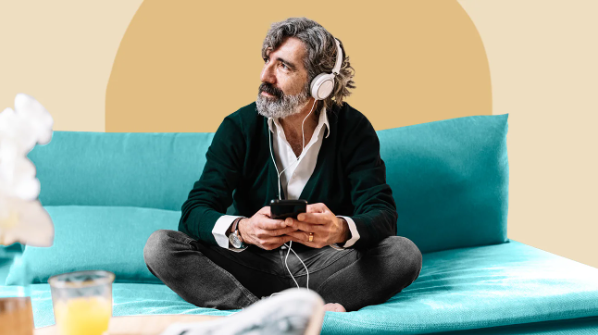There are numerous headphone styles and options available on the market today, making it easy to find something that suits your needs and accommodates most types of hearing aids.
In this article, we’ll explore:
- Types of hearing aids and headphones
- What’s most compatible
- Tips to maximise the use of your hearing devices
Types of Hearing Aids
There are several kinds of hearing aids, including:
- In the ear
- Invisible in the canal
- Completely in the canal
- In the canal
- Behind the ear
These types of hearing aids are compatible with various headphones.
Types of Headphones
- Earbuds: Not ideal, as they interfere with hearing aid placement.
- Over-the-ear: Compatible with most hearing aids. Noise-cancelling options are often over-the-ear, with varying levels of cushioning.
- On-ear: Suitable for hearing aids in the ear canal, such as invisible and completely in the canal models.
- Bone conduction: Best for in-the-ear or in-the-canal hearing aids, as they sit against the cheekbones and do not block the ears.
Pricing
Headphone prices vary widely. High-end models from well-known manufacturers reflect the extensive research into sound quality, but there are also more affordable options that might meet your needs without breaking the bank.
Best Hearing Aid-Compatible Headphones
Shokz OpenMove Bone Conduction Open-Ear Headphones
Price: £
Best with: In the ear, in the canal, completely in the canal, invisible in the canal
Battery life: 6 hours
These bone conduction headphones are budget-friendly and well-reviewed, ideal for exercise due to their sweat resistance. They offer free shipping, returns, and a 2-year warranty.
Sennheiser RS135 On-Ear Wireless RF Headphones with Charging Cradle
Price: ££
Best with: Completely in the canal and invisible in the canal
Battery life: 20 hours
These on-ear headphones feature a charging cradle and are perfect for watching TV with custom sound across a 300-foot range. Though they lack Bluetooth, they provide excellent audio for TV viewing.
Recon 70 Blue Camo Headset
Price: £
Best with: In the ear, in the canal, completely in the canal, invisible in the canal, behind the ear
Battery life: Wired
These affordable, lightweight gaming headphones have a large ear cup and a built-in microphone. They are compatible with multiple gaming systems and standard headphone jacks.
PlayStation PULSE 3D Wireless Headset
Price: £
Best with: In the ear, in the canal, completely in the canal, invisible in the canal, behind the ear
Battery life: 12 hours
These over-the-ear gaming headphones support 3D audio and feature a noise-cancelling microphone. They are rechargeable and connect to mobile devices and PlayStation VR.
Beats Solo3 Wireless Headset
Price: ££
Best with: In the ear, in the canal, completely in the canal, invisible in the canal, behind the ear
Battery life: 40 hours
These over-the-ear headphones are praised for their sound quality and long battery life. They also feature fast charging, voice activation, and volume control.
Bose QuietComfort 45 Wireless Headphones
Price: £££
Best with: In the ear, in the canal, completely in the canal, invisible in the canal, behind the ear
Battery life: 24 hours
Bose is renowned for high-quality audio. These noise-cancelling headphones offer a 24-hour battery life and multiple microphones for clear conversations. They also connect to the Bose Music app for additional features.
Astro A50 Wireless Headset + Base Station
Price: £££
Best with: In the ear, in the canal, completely in the canal, invisible in the canal, behind the ear
Battery life: 15+ hours
Designed for gamers, these headphones feature a charging station, Dolby audio, and a flip-to-mute microphone. They are compatible with PCs, Macs, and PlayStation consoles.
Beyerdynamic Amiron Wireless
Price: £££
Best with: In the ear, in the canal, completely in the canal, invisible in the canal, behind the ear
Battery life: 30+ hours
These top-of-the-line wireless headphones are built to last, with wide, padded ear cups. The accompanying app allows for a customised listening experience.
How to Choose
When selecting the right headphones, consider how you intend to use them: gaming, chatting, taking calls, or listening to music or other audio content.
Before purchasing, read the product details, including dimensions and online reviews. Ensure the headphones work with your hearing aids. For those with asymmetric hearing loss, some headphones offer independent volume controls or balance adjustments via device settings.
Do I Need Headphones If I Have Hearing Aids?
Modern hearing aids often stream external audio directly, making headphones unnecessary. Many allow you to take calls, with the hearing aids acting as the microphone and speaker. Bluetooth or MFi (Made for iPhone/iPod/iPad) connectivity in hearing aids can provide superior sound quality tailored to your hearing loss.
Lainee Levinton, AuD, CCC-A, an audiologist in the Philadelphia metro area, states, “These hearing aids get much better sound quality, as the streaming signal is corrected for your individual hearing loss.” She suggests that hearing loss solutions are highly individual.
Frequently Asked Questions
Are noise-cancelling headphones good for people with hearing loss?
Noise-cancelling headphones help eliminate ambient noise but do not protect against noise damage.
What headphones do audiologists recommend?
Many audiologists prefer over-the-ear headphones for their better seal, which reduces sound leakage and the temptation to increase the volume to unsafe levels.
The Takeaway
Many modern hearing aids come with Bluetooth or MFi capability, making headphones unnecessary. Consult an audiologist to choose the right model for your needs. If you prefer headphones, select a product based on your hearing aids and intended use. There are many options available to suit various preferences and budgets.

